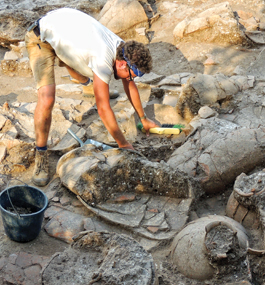A Very Good Vintage

Eric Cline
DIG THIS: Chemical analysis showed residues of honey, mint, cinnamon bark, juniper and resins in 40 wine jars unearthed at Tel Kabri, an ancient palace in Israel.
by Leah Burrows
When it came to celebrating with important guests, ancient Canaanites knew how to party. More than 3,000 years ago, members of the Israelite tribe were spiking their wine with mint, honey and a dash of psychotropic resins.
Archaeologists from Brandeis, the George Washington University and the University of Haifa recently unearthed the oldest — and largest — palatial wine cellar ever found in the Near East at Tel Kabri, a ruined palace that dates to about 1700 B.C., built in what was once a sprawling Canaanite city in northern Israel. In the wine cellar, the researchers discovered 40 jars, each of which would have held 50 liters of strong, sweet grape wine.
With help from the Brandeis chemistry department, team member Andrew Koh, assistant professor of classical studies, analyzed jar fragments using organic residue analysis. Collaborating with professors Barry Snider, Christine Thomas, Casey Wade and Isaac Krauss, he found molecular traces of tartaric and syringic acid, both key components in wine. The team also identified compounds suggesting ingredients popular in ancient winemaking, including honey, mint, cinnamon bark, juniper berries and resins. The recipe is similar to medicinal wines used in ancient Egypt for 2,000 years.
Koh analyzed the proportions of each diagnostic compound and discovered remarkable consistency among the jars. “This wasn’t moonshine that someone was brewing in their basement, eyeballing the measurements,” he notes. “This wine’s recipe was strictly followed in each and every jar.”
The wine cellar is located near a hall where banquets may have been held, a room in which the Kabri elite and possibly foreign guests may have consumed goat meat and wine. The hosts of these banquets remain a mystery. Archaeologists have uncovered no written records or seals that indicate who lived at the palace, which is located not far from many of Israel’s modern-day wineries. The building was abandoned around 1500 B.C. for unknown reasons.
At the end of the excavating season last fall, the international team, which included a group of Brandeis students, discovered two doors leading out of the wine cellar — one to the south and the other to the north — presumably to additional storage rooms. Team members will have to wait until 2015, when the dig resumes, to find out for sure.
